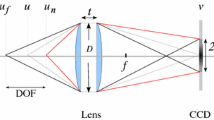Abstract
This paper is concerned with active sensing of range information from focus. It describes a new type of camera whose sensor plane is not perpendicular to the optical axis as is standard. This special imaging geometry eliminates sensor plane movement usually necessary for focusing. Camera panning, required for panoramic viewing anyway, in addition enables focusing and range estimation. Thus panning integrates the two standard mechanical actions of focusing and panning, implying range estimation is done at the speed of panning. An implementation of the proposed Non-frontal Imaging Camera (NICAM) design is described. Experiments on range estimation are also presented.
Similar content being viewed by others
References
Abbott, A.L. and Ahuja, N. 1988. Surface reconstruction by dynamic integration of focus, camera vergence, and stereo. In Proc. Second Intl. Conf. Computer Vision, Tarpon Springs, Fla, pp. 532–543.
AhujaN. and AbbottA.L. 1993. Active stereo-integrating disparity, vergence, focus, aperture, and calibration for surface estimation, IEEE Trans. Pattern Anal. Machine, Intell., 15(10):1007–1029.
Darrell, T. and Wohn, K. 1988. Pyramid based depth from focus. In Proc. IEEE Conf. Computer Vision and Pattern Recognition, pp. 504–509.
Das, S. and Ahuja, N. 1990. Multiresolution image acquisition and surface reconstruction. In Proc. Third Intl. Conf. Computer Vision, Osaka, Japan, pp. 485–488.
Das, S. and Ahuja, N. 1992. Active surface estimation: Integrating coarse-to-fine image acquisition and estimation from multiple cues. Technical Report CV-92-5-2, Beckman Institute, University of Illinois.
Das, S. and Ahuja, N. 1993. A comparative study of stereo, vergence, and focus as depth cues for active vision. In Proceedings of the Conference on Computer Vision and Pattern Recognition, pp. 194–199, New York City, NY.
Ens, J. and Lawrence, P. 1991. A matrix based method for determining depth from focus. In Proc. IEEE Conf. Computer Vision and Pattern Recognition, Maui, Hawaii, pp. 600–606.
Goodman, J.W. 1968. Introduction to Fourier Optics. McGraw-Hill; Physical and Quantum Electronics Series.
Jarvis R.A. 1976. Focus optimisation criteria for computer image processing. Microscope, 24:163–180.
Klaus B. and Horn P. 1968. Focusing, Technical Report 160, MIT Artificial Intelligence Lab, Cambridge, Mass.
Krishnan, A. and Ahuja, N. 1993a. Range estimation from focus, using a non-frontal imaging camera. In Proceedings of the DARPA Image Understanding Workshop, Washington, D.C. pp. 959–965.
Krishnan, A. and Ahuja, N. 1993b. Range estimation from focus using a non-frontal imaging camera. In Proceedings of the Eleventh National Conference on Artificial Intelligence, Washington, D.C. pp. 830–835.
Krishnan, A. and Ahuja, N. 1993c. Stereo display of large scenes from monocular images using a novel non-frontal camera. In Proceedings of ACCV-93 Asian Conference on Computer Vision. Osaka, Japan, pp. 133–136.
Krishnan, A. and Ahuja, N. 1993d. Use of a non-frontal camera for extended depth of field in wide scenes. In Proceedings of the SPIE Conference on Intelligent Robots and Computer Vision XII: Active Vision and 3D Methods, Boston MA, pp. 62–72.
Krishnan, A. and Ahuja, N. 1994. Depth of field for tilted sensor plane. Technical Report UIUC-BI-AI-RCV-94-08, Beckman Institute, University of Illinois.
Krotkov E.P. 1987. Focusing. International Journal of Computer Vision, 1(3):223–237.
Krotkov E.P. 1989. Active Computer Vision by Cooperative Focus and Stereo. Springer-Verlag: New York.
Krotkov, E.P., Summers, J., and Fuma, F. 1986. Computing range with an active camera system. In Eighth International Conference on Pattern Recognition, pp. 1156–1158.
Ligthart, G. and Groen, F.C.A. 1982. A comparison of different autofocus algorithms. In Proc. Sixth Intl. Conf. Pattern Recognition, pp. 597–600.
Nayar, S.K. and Nakagawa, Y. 1990. Shape from focus: An effective approach for rough surfaces. In Proc. IEEE Intl. Conf. Robotics and Automation, Cincinnati, Ohio, pp. 218–225.
Pentland, A., Darrell, T., Turk, M., and Huang, W. 1989. A simple, real-time range camera. In IEEE Computer Society Conference on Computer Vision and Pattern Recognition, pp. 256–261.
Pentland A.P. 1987. A new sense for depth of field. IEEE Trans. Pattern Anal. and Machine Intell., PAMI-9:523–531.
Schlag, J.F., Sanderson, A.C., Neuman, C.P., and Wimberly, F.C. 1985. Implementation of automatic focusing algorithms for a computer vision system with camera control. Technical Report CMU-RI-TR-83-14, Carnegie-Mellon University.
Sperling G. 1970. Binocular vision: A physical and a neural theory. Amer. J. Psychology, 83:461–534.
Tenenbaum, J.M. 1971. Accomodation in computer vision. Ph.D. Thesis, Stanford University, Palo Alto, Calif.
Wilcox, B. 1993. Personal communication on tilted sensor plane camera with scanning mirror.
Xiong, Y. and Shafer, S.A. 1993. Depth from focusing and defocusing. In Proceedings of the Conference on Computer Vision and Pattern Recognition, New York City, NY, pp. 68–73.
Author information
Authors and Affiliations
Additional information
The support of the National Science Foundation and Defense Advanced Research Projects Agency under grant IRI-89-02728 and U.S. Army Advance Construction Technology Center under grant DAAL 03-87-K-0006 is gratefully acknowledged.
Rights and permissions
About this article
Cite this article
Krishnan, A., Ahuja, N. Range estimation from focus using a non-frontal imaging camera. Int J Comput Vision 20, 169–185 (1996). https://doi.org/10.1007/BF00208718
Received:
Revised:
Issue Date:
DOI: https://doi.org/10.1007/BF00208718




